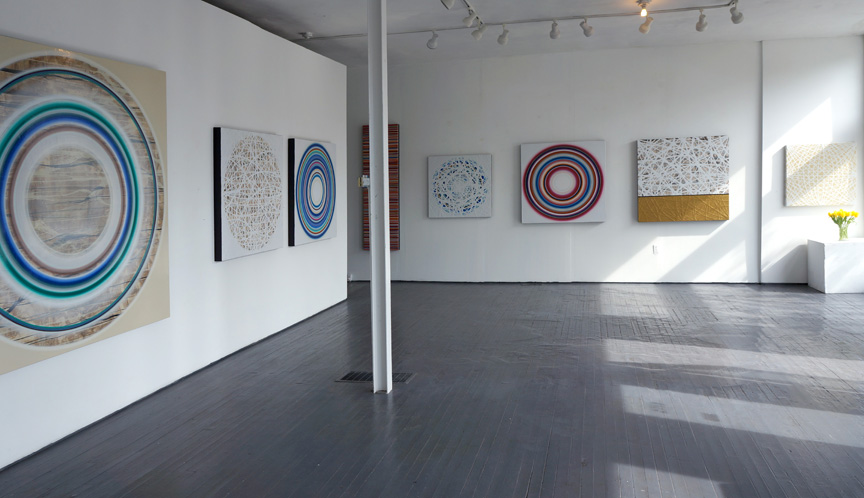Target Practice: Michael Hoffman’s Inventive Methodologies
“…everything
was rainbow, rainbow, rainbow!
And I let the fish go.”
~Elizabeth Bishop, “The Fish”
To relinquish one’s sense of control proves not only a mammoth day-to-day task, but an increasingly difficult spiritual calling, and artists have long intuited what the enlightened already know: control itself is always illusory. From Jackson Pollock to John Cage to Merce Cunningham, the means of forfeiting will to chance may vary, but persist across genre and form to this day. For Michael Hoffman, who started painting in his thirties, the eclectic nature of his early years lent a sense of experiment to his praxis, one that mixes vivid minimalism with a spirit of chance and play. His canvasses come to life less through visions of a final product and more through a focus on process in flux.
In Order / Discord, Hoffman’s latest paintings expose both a love for the sleekness of mid-century design and an abiding attention to the expressive power of color. “Before I got into painting on my own, I really loved socio-political art,” says Hoffman. “But when you make something really political, eventually that becomes all it stands for. Now that I paint myself, I like doing something more universal.” An indebtedness to abstract expressionists clearly on view, Hoffman’s paintings assume a look all their own through the original methods by which they are executed. Many appear incredibly precise from a far, but up close betray the artist’s hand, a curve in a brushstroke, a wavering line.
“Like a leaf skeleton,” says the artist, “it looks perfect, but it is actually full of imperfection.” In works like Outside Marrakech, Rayleigh Scattering, and Milk and Honey, a web-like pattern dominates; the lines appear organized and geometric, but in fact are not—or at least not quite. To prepare his canvasses, Hoffman coats a wood panel with a plaster mixture, creating a sense of tactility—in some works, like Winter Pulse and Kyoto Candy, this “half-random, half-controlled” admixture passes for cirrus and cumulous clouds, a diffused skyline in tension with the apparent geometry of the work from afar. Targets small, large, and giant comprise a bright motif throughout the show—seducing the eye, reshaping perception. Are those the rings of Saturn, or a plated egg served sunny-side up? A planetary, mildly psychedelic vibe circulates the series.
Hoffman was raised in New York’s bohemian East Village, years before it became the gentrified hamlet it is today. By the late 1980s, he had relocated to Europe, traveling with a small-scale circus—fire-spinning and handspringing his way from town to town with a band of raffish performers. As such, it is no surprise that his current work on canvas displays a certain acrobatic quality.
For several pieces—like Outside Marrakech and December Garden—Hoffman poured paint in fluid arcs while standing above the canvas, the gestural rhythms not unlike that of a juggler tossing pins in nimble succession. For his target works—like Winter Pulse and Swimming St. Tropez—he built his own contraption, partly inspired by the Sit-and-Spin that his children enjoyed when they were young.
From a bicycle wheel Hoffman devised a rotating platform upon which a canvas could be spun—a whirring surface resembling as much a Ringling act as a potter’s wheel.
Accenting many of his paintings, a yummy gustatory quality often catches one off guard. Kyoto Candy radiates with LifeSaver sweetness; Milk and Honey passes for a grid of frosted comb; Winter Pulse reminds one of a glazed donut sinking into a bowl of cream. “Like music, the images mean something different to everyone who listens,” says Hoffman, as, indeed, in his Target Series, the visual seems to take on an auditory resonance. Order / Discord briefly becomes “Disc Order”, as some targets start to spin like a turntable or elliptical drive. One canvas looks like the inside of a glass-blown vase, another an eyeball with a Sunkist pupil. A full moon turns into a blood moon, a Mento mint left out in the rain.
“Not studying painting formally,” explains Hoffman. “I’ve had the freedom to experiment with paint and play.” Such unloosed impulses loom epic in Eventide, at once lunar and oceanic, and the largest painting he has yet to complete. “I love working big,” he jests, as composing this piece literally tested his wingspan.
Other works bear titles redolent of cities and regions important to Hoffman’s past. Playa Ibiza and Granada Road pay homage to the Mediterranean hues of coastal Spain. A white sun at its center, Swimming St. Tropez summons up grade-school “ROYGBIV” memories. Noche Barcelona is the warmer, bolder cousin of Kyoto Candy. In Bordeaux, hung vertically, reds and oranges drip from the edges, evidence of Hoffman’s application of stripes with the canvas flipped horizontal.
The aesthetic love child of Swimming St. Tropez and Plexus, Rayleigh Scattering waxes more conceptual, its title referring to the scattering of light off the molecules of air that gives the sky its blue color. In December Garden, gold paint flattens the lower fourth of the canvas, reminding one of a gilded gala to distract from the dreary seasonal terrain.
However abstract, Hoffman’s ludic dreamscapes call to mind a better world, one that at present is perhaps needed more than ever.
Eileen G'Sell’s poetry and cultural criticism are regularly featured in Salon, VICE, ALIVE, Arte Fuse New York, DIAGRAM, the Boston Review, and Conduit, among others. She is Film & Media editor at the Rumpus and teaches writing, film, and poetry at Washington University in St. Louis.
